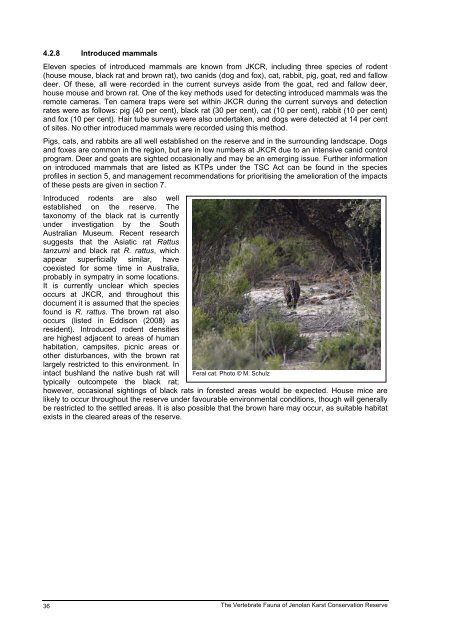The Vertebrate Fauna of Jenolan Karst Conservation Reserve: Final
The Vertebrate Fauna of Jenolan Karst Conservation Reserve: Final
The Vertebrate Fauna of Jenolan Karst Conservation Reserve: Final
Create successful ePaper yourself
Turn your PDF publications into a flip-book with our unique Google optimized e-Paper software.
4.2.8 Introduced mammals<br />
Eleven species <strong>of</strong> introduced mammals are known from JKCR, including three species <strong>of</strong> rodent<br />
(house mouse, black rat and brown rat), two canids (dog and fox), cat, rabbit, pig, goat, red and fallow<br />
deer. Of these, all were recorded in the current surveys aside from the goat, red and fallow deer,<br />
house mouse and brown rat. One <strong>of</strong> the key methods used for detecting introduced mammals was the<br />
remote cameras. Ten camera traps were set within JKCR during the current surveys and detection<br />
rates were as follows: pig (40 per cent), black rat (30 per cent), cat (10 per cent), rabbit (10 per cent)<br />
and fox (10 per cent). Hair tube surveys were also undertaken, and dogs were detected at 14 per cent<br />
<strong>of</strong> sites. No other introduced mammals were recorded using this method.<br />
Pigs, cats, and rabbits are all well established on the reserve and in the surrounding landscape. Dogs<br />
and foxes are common in the region, but are in low numbers at JKCR due to an intensive canid control<br />
program. Deer and goats are sighted occasionally and may be an emerging issue. Further information<br />
on introduced mammals that are listed as KTPs under the TSC Act can be found in the species<br />
pr<strong>of</strong>iles in section 5, and management recommendations for prioritising the amelioration <strong>of</strong> the impacts<br />
<strong>of</strong> these pests are given in section 7.<br />
Introduced rodents are also well<br />
established on the reserve. <strong>The</strong><br />
taxonomy <strong>of</strong> the black rat is currently<br />
under investigation by the South<br />
Australian Museum. Recent research<br />
suggests that the Asiatic rat Rattus<br />
tanzumi and black rat R. rattus, which<br />
appear superficially similar, have<br />
coexisted for some time in Australia,<br />
probably in sympatry in some locations.<br />
It is currently unclear which species<br />
occurs at JKCR, and throughout this<br />
document it is assumed that the species<br />
found is R. rattus. <strong>The</strong> brown rat also<br />
occurs (listed in Eddison (2008) as<br />
resident). Introduced rodent densities<br />
are highest adjacent to areas <strong>of</strong> human<br />
habitation, campsites, picnic areas or<br />
other disturbances, with the brown rat<br />
largely restricted to this environment. In<br />
intact bushland the native bush rat will<br />
typically outcompete the black rat;<br />
Feral cat. Photo © M. Schulz<br />
however, occasional sightings <strong>of</strong> black rats in forested areas would be expected. House mice are<br />
likely to occur throughout the reserve under favourable environmental conditions, though will generally<br />
be restricted to the settled areas. It is also possible that the brown hare may occur, as suitable habitat<br />
exists in the cleared areas <strong>of</strong> the reserve.<br />
36<br />
<strong>The</strong> <strong>Vertebrate</strong> <strong>Fauna</strong> <strong>of</strong> <strong>Jenolan</strong> <strong>Karst</strong> <strong>Conservation</strong> <strong>Reserve</strong>

















